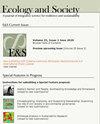紧凑型城市公共绿地场地属性与植物物种选择的评价感知
IF 3.2
2区 社会学
Q1 ECOLOGY
引用次数: 0
摘要
了解市民对城市公共绿地(UGS)属性和植物物种特征的评价,可以为绿色空间设计提供信息,以满足公众的期望。本研究以827名成年人为对象,进行问卷调查,以评估市民对UGS属性和植物种类的反应。采用主成分分析和聚类分析对数据进行分析。根据对UGS属性的评价,将受访者分为三类(生态型、折衷型和实用型)。此外,通过对植物物种特征的评价,将保护支持者、全能完美主义者和安全捍卫者分为三类。植物知识和性别是影响被调查者评价概况的主要因素。被调查者对UGS属性的期望不同,对植物物种特征的评价也不同。回应团体一致同意,香港各普查地点均有类似的植物种类组成。重视植物物种保护价值的受访者(即“保护支持者”)更关注植物物种选择。保护支持者对目前的植物选择策略不满意。大型UGS的分区策略可以满足广泛的用户需求,并为居民创造一个具有社会包容性的场所。另一种选择是,在特定地区的小型UGS集合可以覆盖一系列功能。研究结果可以为UGS的设计和植物选择提供改进的方法,以满足居民不同的期望和需求。本文章由计算机程序翻译,如有差异,请以英文原文为准。
Evaluation-perception of site attributes and plant species selection in the public urban green space of a compact city
Understanding citizens’ evaluation of public urban green space (UGS) attributes and plant species features can inform greenspace design to meet public expectations. This study evaluated the public’s responses to UGS attributes and plant species in Hong Kong using a questionnaire survey of 827 adult respondents. Principal component analysis followed by cluster analysis were applied to analyze the data. The respondents were differentiated into three groups (ecological, eclectic, and pragmatic users) based on the evaluations of UGS attributes. Additionally, three clusters (conservation supporters, all-round perfectionists, and safety defenders) were classified based on evaluating plant species features. Plant knowledge and gender were the main factors associated with respondents’ evaluation profiles. Respondents with different expectations of UGS attributes harbored different evaluations of plant species features. The respondent groups agreed unanimously that similar plant species composition was deployed across UGS sites in Hong Kong. Respondents attaching importance to the conservation value of plant species (i.e., “conservation supporters”) were more concerned about plant species selection. The conservation supporters were dissatisfied with the current plant selection strategy. A zonation strategy for large UGS could cater to a broad range of user demands and create a socially-inclusive venue for residents. Alternatively, a collection of small UGS in a given district can cover a range of functions. The findings could inform a modified approach to UGS design and plant selection to satisfy the residents’ disparate expectations and needs.
求助全文
通过发布文献求助,成功后即可免费获取论文全文。
去求助
来源期刊

Ecology and Society
环境科学-生态学
CiteScore
6.20
自引率
4.90%
发文量
109
审稿时长
3 months
期刊介绍:
Ecology and Society is an electronic, peer-reviewed, multi-disciplinary journal devoted to the rapid dissemination of current research. Manuscript submission, peer review, and publication are all handled on the Internet. Software developed for the journal automates all clerical steps during peer review, facilitates a double-blind peer review process, and allows authors and editors to follow the progress of peer review on the Internet. As articles are accepted, they are published in an "Issue in Progress." At four month intervals the Issue-in-Progress is declared a New Issue, and subscribers receive the Table of Contents of the issue via email. Our turn-around time (submission to publication) averages around 350 days.
We encourage publication of special features. Special features are comprised of a set of manuscripts that address a single theme, and include an introductory and summary manuscript. The individual contributions are published in regular issues, and the special feature manuscripts are linked through a table of contents and announced on the journal''s main page.
The journal seeks papers that are novel, integrative and written in a way that is accessible to a wide audience that includes an array of disciplines from the natural sciences, social sciences, and the humanities concerned with the relationship between society and the life-supporting ecosystems on which human wellbeing ultimately depends.
 求助内容:
求助内容: 应助结果提醒方式:
应助结果提醒方式:


